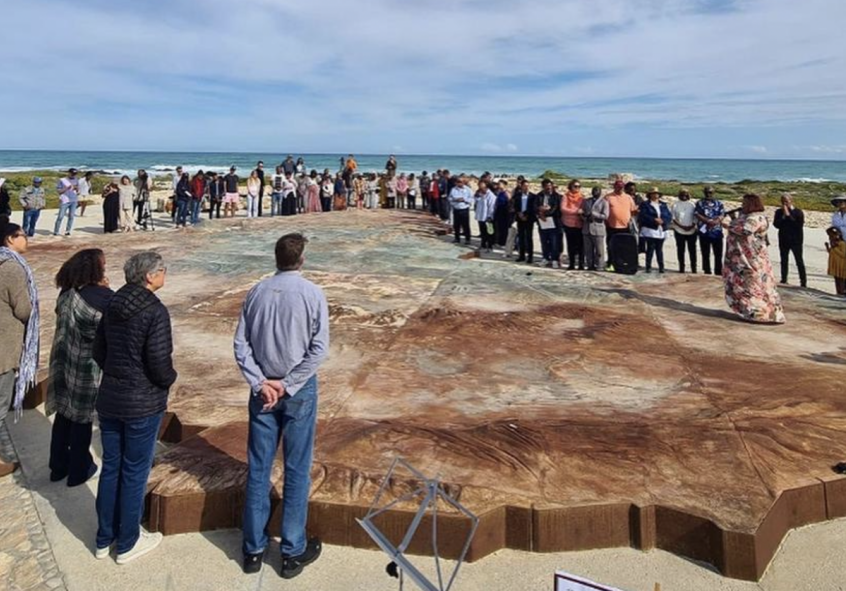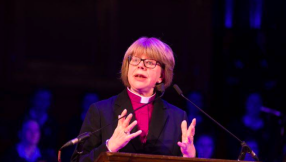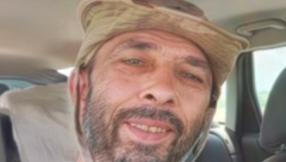
Setting the path
Reconciliation in post-apartheid South Africa has many faces. One of them is the Pilgrimage of Grace, inspired by faithful women of prayer such as Anneke Rabe and Hanneli Rupert-Koechelenberg and organized by the South African Christian Leadership Initiative (SACLI).
Hanneli and her family have created a beautiful place of peace and healing in the midst of their great winery estate in Franschhoek called "in Harmonie". The staff of this retreat centre coordinated the pilgrimage and offered their great hospitality to us.
SACLI works alongside the South African Evangelical Alliance (SAEA) led by Moss Nthla, who invited me and my wife Cornelia to join the Pilgrimage on September 23-25 this year in the Cape province. It became an unforgettable journey of peace and reconciliation.
Our journey started in the Moravian Hill Church in District Six of Cape Town. Once inhabited by the native Khoi people, this inner-city district of Cape Town became famous for the inhumane uprooting of the Khoi and their diverse neighborhood by the apartheid regime, for taking down their houses and businesses and also for closing their churches.
Over 60,000 of its inhabitants were forcibly removed during the 1970s by the Whites' regime. Only after the end of apartheid was the historic church building from 1886 handed back and today, this first non-white church in the Cape stands as a powerful witness of the struggle of the Khoi and other South African tribes for freedom and human dignity.
The worship service in this church set the 60 pilgrims on the path of reconciliation. They came from different Christian denominations and organizations across South Africa. A few guests came from abroad[JR1] . We were invited to witness and support a fascinating reconciliation act between the two oldest churches in the country: the white Dutch Reformed Church (DRC) and the indigenous Moravian Church.
For 300 years these two churches have lived in constant tension by which the Moravians were dehumanized, misused and mistreated, and the DRC stood on the side of the oppressor and even delivered dubious theological justifications for the system of oppression. Now they
After the service in the Moravian Hill Church we walked through the city, praying for the diverse population around us and confessing the sins of European invaders at the Castle of Good Hope, now a centre for restoration. Then we approached the Groote Kerk in the centre of Cape Town, built originally in 1678 and the oldest Christian church in South Africa. Today's impressive DRC building was erected in 1704 and enlarged in 1843, becoming the proud spiritual centre of the (white) Afrikaaner church.
The pilgrimage community, now joined by many other Capetonians, gathered in the church for worship and Nthla preached the sermon, reminding the pilgrims of both the great blessing which grew out of the European Christian presence among the native African tribes and the unfortunate development of racially segregated Christianity in South Africa.
He urgently appealed to his fellow South Africans to overcome that painful history, heal their memories, and join hands in building up the kingdom of God among the nations of South Africa. Stories of personal reconciliation between white and black brothers and sisters followed the sermon. Some of them deeply touched our hearts. Praying and singing together, we the pilgrims were ready to move on to Genadendal, where the mission among the native tribes in South Africa began.
In the valley of grace
Genadendal (Afrikaans for Valley of Grace) is a small town in Eastern Cape. Here the German missionary Georg Schmidt (1709-1785) started his mission among the Khoi people in 1737. And here the first church among the African tribes of the Khoi and San people was established in 1738. In this historic church of Genadendal on Heritage day, 24September 2022, the two oldest churches of South Africa decided to reconcile with one another after 300 years of tension and even persecution of the Moravians through the DRC.
This milestone event started with an introduction to the history of the relationship of the two churches by the vice-president of the Moravian Church of Western Cape, Rev Martin Abrahams. While he introduced the historic problem, a dove flew into the church building and sat down on the gallery above the pulpit. As soon as Abrahams invited the gathered community to participate in prayers and support for the reconciliatory act, the dove flew over the sanctuary. It was an amazing picture.
We sang together before moderator of the DRC, pastor N Janse van Rensburg, read from the Scriptures and confessed the sins of the DRC to the Moravians and God. He especially underlined the fact that the DRC hindered the mostly indigenous Moravian Church to develop.
"My church stood in the way of God's mission to African native tribes," he said.
"We have sinned against God and people – please forgive us."
Van Rensburg spoke in a deeply moving manner and his tears caused most of us to well up. And while he made his confession, the dove returned to the front of the church and posted itself again above the pulpit, as if the Holy Spirit was sending it to witness to this historic confession.
His confession was followed by a response of the Moravian leadership. Not only did they forgive the DRC, but they also pointed to their own sin, especially towards the neglected acknowledgment of the women in their church. And again, a plea for forgiveness reached the women, and reconciliation between men and women in the leadership of the Moravian Church was established by naming some of the most extraordinary female leaders among the Moravians and honouring their contribution to both the mission among the Khoi in the early days and the struggle against the Apartheid system in South Africa in the 20<sup>th century.
At the end of the service both churches committed to working together for the building up of God´s kingdom in South Africa beyond any racial, ethnic or cultural divides.
"We will work together for a nation in which God's mission embraces all people," underlined the DRC bishop.
I need to confess, seldom have I participated in such a spiritually loaded service. God was present in this old church in every word, in every piece of music and singing and in every prayer. Our pilgrimage has led us to a place of God's divine presence. We, the pilgrims were witnessing God in action.
"Reconciliation is truly the place where our Lord is at home," a brother from South Africa said after we left the church. And he expressed my own thoughts and feelings.
With the end of the service the celebration around the churchyard went on. Young people from Genadendal did a re-enactment of the first German missionaries who came to the Khoi, and all the historic buildings opened their doors. Even the historic bell rang again inviting the faithful to be thankful for what God did in 300 years of history and how He has just started to heal the memories of both Christians from the DRC and the Moravian Church. The pilgrims were thankful and set their path forth in deep expectation for great things to come to this wonderful nation of South Africa.
Salt for the African soil
We left Genadendal with hope in our hearts to get together at another exciting place of peace and reconciliation - Volmoed. Located in a beautiful valley in the Western Cape, this ecumenic centre for peace and reconciliation was established by a small group of dedicated Christians from different denominations around the famous theology professor John W de Gruchy, author of the widely read book, Reconciliation: Restoring Justice.
Today the centre combines a Benedictine monastery and an ecumenic retreat and conference centre serving the wider community.
"All we are concerned about," de Gruchy said in his welcoming address to our pilgrimage group, "is reconciliation, or the restoration of humanity and nature into God's original image. Here in Volmoed you find Christians reconciled with one another, working together for peace across all denominational lines. You are welcome to join us in our efforts, and we will obviously be with you on your journey of reconciliation."
Yes, we felt welcome in this peaceful spiritual centre.
"We come here often with our YWAM discipleship school," explained the leader of YWAM South Africa, M Filies.
"It is exciting to see how our young people from around the world get transformed in Volmoed. Nothing is as true as the fact that God is present here and His Spirit transforms lives to be agents of peace. For many of them their personal pilgrimage of reconciliation starts exactly here. Like Taizé in Europe, Volmoed serves people to make them ambassadors of peace."
What a great place to be for a group of pilgrims like us!
The last station on our pilgrimage was marked by Cape Agulhas, the southernmost point of the African continent. Here at the shore of where the Indian Ocean meets the Atlantic, we gathered around a huge relief map of the continent. And here again we confessed the sins of the European nations against African tribes. Great Britain, the Netherlands, France, Germany, Portugal, Spain and in recent years the US and Russia all added to the agony of most African nations.
On behalf of those nations some representatives from Europe and the Americas asked the Africans and God for forgiveness and pleaded with the Lord to reconcile us with one another to fulfil our God-given mission.
This was expressed in extensive confessions and lament. And representatives from African nations forgave us and asked God to transform our Christian churches into a united force to be God's true agents of transformation and peace.
It was exciting to see how the two reconciled churches in Genadendal, the DRC and the Moravians, engaged in helping to cast a joint vision for Africa and the world. In prayer, worship and testimonial stories they encouraged our group to stay active in the mission of reconciliation. They reminded us to be salt of the earth and light of the world. To illustrate this, Pastor van Rensburg gave every participant some salt, and together we covered the map of Africa with salt, promising to be salt – a preservative and nourishing mineral – for the African soil. What a symbol this was!
Our pilgrimage of grace came to an end at Cape Agulhas, but the mission has not stopped. From September 26, a 54-day global prayer chain for Africa was started. All Christians around the world are invited to join in systematic praying for the African nations, one after the other. I suppose many pilgrimages of grace will be needed to reconcile our broken world, and we can all become active participants. Let's start in this kind of prayer now, fellow Christians!













